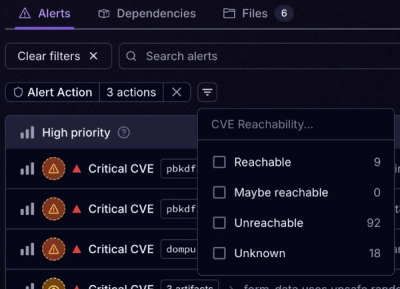
Product
Announcing Socket Fix 2.0
Socket Fix 2.0 brings targeted CVE remediation, smarter upgrade planning, and broader ecosystem support to help developers get to zero alerts.
@ngneat/until-destroy
Advanced tools
RxJS operator that unsubscribes when Angular component is destroyed
@ngneat/until-destroy is an Angular utility that helps manage the lifecycle of subscriptions and other resources in Angular components and services. It automatically unsubscribes from observables when the component or service is destroyed, preventing memory leaks and reducing boilerplate code.
Automatic Unsubscription
This feature allows automatic unsubscription from observables when the component is destroyed. The `untilDestroyed` operator is used to bind the observable to the component's lifecycle.
import { Component } from '@angular/core';
import { UntilDestroy, untilDestroyed } from '@ngneat/until-destroy';
import { interval } from 'rxjs';
@UntilDestroy()
@Component({
selector: 'app-example',
template: '<p>Example works!</p>'
})
export class ExampleComponent {
constructor() {
interval(1000)
.pipe(untilDestroyed(this))
.subscribe(val => console.log(val));
}
}Service Support
This feature extends the automatic unsubscription functionality to services. The `untilDestroyed` operator can be used in services to manage subscriptions and other resources.
import { Injectable } from '@angular/core';
import { UntilDestroy, untilDestroyed } from '@ngneat/until-destroy';
import { interval } from 'rxjs';
@UntilDestroy()
@Injectable({
providedIn: 'root'
})
export class ExampleService {
constructor() {
interval(1000)
.pipe(untilDestroyed(this))
.subscribe(val => console.log(val));
}
}Directive Support
This feature allows the use of `untilDestroyed` in directives, providing the same automatic unsubscription functionality as in components and services.
import { Directive, OnDestroy } from '@angular/core';
import { UntilDestroy, untilDestroyed } from '@ngneat/until-destroy';
import { interval } from 'rxjs';
@UntilDestroy()
@Directive({
selector: '[appExample]'
})
export class ExampleDirective implements OnDestroy {
constructor() {
interval(1000)
.pipe(untilDestroyed(this))
.subscribe(val => console.log(val));
}
ngOnDestroy() {
// Custom cleanup logic if needed
}
}ngx-take-until-destroy is another Angular utility for managing subscriptions. It provides a similar functionality to @ngneat/until-destroy by using a `takeUntilDestroy` operator to handle unsubscriptions. However, @ngneat/until-destroy offers a more modern and streamlined API.
take-until-destroy is a lightweight library that helps manage subscriptions in Angular components. It uses a `takeUntil` operator to unsubscribe from observables. While it provides similar functionality, @ngneat/until-destroy offers a more comprehensive and integrated solution.
A neat way to unsubscribe from observables when the component destroyed
| @ngneat/until-destroy | Angular |
|---|---|
| 8.x | >= 10.0.5 < 13 |
| 9.x | >= 13 |
npm install @ngneat/until-destroy
# Or if you use yarn
yarn add @ngneat/until-destroy
import { UntilDestroy, untilDestroyed } from '@ngneat/until-destroy';
@UntilDestroy()
@Component({})
export class InboxComponent {
ngOnInit() {
interval(1000).pipe(untilDestroyed(this)).subscribe();
}
}
You can set the checkProperties option to true if you want to unsubscribe from subscriptions properties automatically:
@UntilDestroy({ checkProperties: true })
@Component({})
export class HomeComponent {
// We'll dispose it on destroy
subscription = fromEvent(document, 'mousemove').subscribe();
}
You can set the arrayName property if you want to unsubscribe from each subscription in the specified array.
@UntilDestroy({ arrayName: 'subscriptions' })
@Component({})
export class HomeComponent {
subscriptions = [
fromEvent(document, 'click').subscribe(),
fromEvent(document, 'mousemove').subscribe(),
];
// You can still use the operator
ngOnInit() {
interval(1000).pipe(untilDestroyed(this));
}
}
You can set the blackList property if you don't want to unsubscribe from one or more subscriptions.
@UntilDestroy({ checkProperties: true, blackList: ['subscription1'] })
@Component({})
export class HomeComponent {
// subscription1 will not be unsubscribed upon component destruction
subscription1: Subscription;
// subscription2 will be unsubscribed upon component destruction
subscription2: Subscription;
constructor() {
this.subscription1 = new Subject().subscribe();
this.subscription2 = new Subject().subscribe();
}
}
@UntilDestroy()
@Injectable()
export class InboxService {
constructor() {
interval(1000).pipe(untilDestroyed(this)).subscribe();
}
}
@Component({
providers: [InboxService],
})
export class InboxComponent {
constructor(inboxService: InboxService) {}
}
All options, described above, are also applicable to providers.
npm install ngx-take-until-destroy
# Or if you use yarn
yarn add ngx-take-until-destroy
import { untilDestroyed } from 'ngx-take-until-destroy';
@Component({})
export class InboxComponent implements OnDestroy {
ngOnInit() {
interval(1000)
.pipe(untilDestroyed(this))
.subscribe(val => console.log(val));
}
// This method must be present, even if empty.
ngOnDestroy() {
// To protect you, we'll throw an error if it doesn't exist.
}
}
import { untilDestroyed } from 'ngx-take-until-destroy';
export class Widget {
constructor() {
interval(1000).pipe(untilDestroyed(this, 'destroy')).subscribe(console.log);
}
// The name needs to be the same as the second parameter
destroy() {}
}
To make it easier for you to migrate, we've built a script that will update the imports path and add the decorator for you. The script is shipped as a separate package. Run the following command to install it:
npm i --save-dev @ngneat/until-destroy-migration
# Or if you use yarn
yarn add -D @ngneat/until-destroy-migration
Then run the following command:
npx @ngneat/until-destroy-migration --base my/path
base defaults to ./src/app.
You can use the --removeOnDestroy flag for empty OnDestroy methods removing.
npx @ngneat/until-destroy-migration --removeOnDestroy
You can remove the package once the migration is done.
@UntilDestroy() before the @Component() decorator.overrideComponent in unit tests remember that it overrides metadata and component definition. Invoke UntilDestroy()(YourComponent); to reapply the decorator. See here for an example.Thanks goes to these wonderful people (emoji key):
Netanel Basal 💻 📖 🤔 | Artur Androsovych 💻 💡 🤔 🚇 | Krzysztof Karol 🖋 | Alex Malkevich 💻 | Khaled Shaaban 💻 | kmathy 💻 | Dmitrii Korostelev 💻 |
This project follows the all-contributors specification. Contributions of any kind welcome!
FAQs
RxJS operator that unsubscribes when Angular component is destroyed
The npm package @ngneat/until-destroy receives a total of 157,721 weekly downloads. As such, @ngneat/until-destroy popularity was classified as popular.
We found that @ngneat/until-destroy demonstrated a not healthy version release cadence and project activity because the last version was released a year ago. It has 4 open source maintainers collaborating on the project.
Did you know?

Socket for GitHub automatically highlights issues in each pull request and monitors the health of all your open source dependencies. Discover the contents of your packages and block harmful activity before you install or update your dependencies.

Product
Socket Fix 2.0 brings targeted CVE remediation, smarter upgrade planning, and broader ecosystem support to help developers get to zero alerts.

Security News
Socket CEO Feross Aboukhadijeh joins Risky Business Weekly to unpack recent npm phishing attacks, their limited impact, and the risks if attackers get smarter.

Product
Socket’s new Tier 1 Reachability filters out up to 80% of irrelevant CVEs, so security teams can focus on the vulnerabilities that matter.